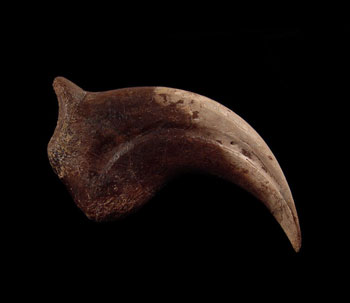
Are you a fossil collector? You must have heard about the recent discovery of three partial skeletons of a raptor dinosaur by U.S paleontologists back in 2014. The dinosaur was named Anzu wyliei. In Sumerian mythology, ‘Anzu’ is a bird-like demon; ‘Wyliei,’ the species name, which honors Pittsburgh’s Carnegie Museum’s Trustee’s grandson.
If we talk about appearance, the creature who lived almost 66 million years ago when the king of the dinosaurs, T-Rex, also roamed around the earth, looks like a modern emu’s and a reptile’s cross.
From one fossil enthusiast to another, Anzu claws for sale are available with us, and they will be a great addition to your collection!
Where were the Anzu fossils discovered?
The specimens were extracted from the Hell Creek Formation in the North and South Dakota’s uppermost level. Due to its bird-like appearance and the place of discovery, the creature was jokingly referred to as the “Chicken from Hell.” If you are not aware of Hell Creek Formation’s significance, it is highly valued because of the abundance of T-Rex and Triceratops fossils found there.
The discovery of these skeletons was nothing short of a breakthrough as it provided a much-needed opportunity to understand a dinosaur group about which not much was known. After remaining enveloped in mystery for about a century, the 2014 extraction allowed the scientists to shed light on the anatomy as well as Caenagnathidae’s evolutionary relationships. Anzu is a Caenagnathidae, a type of Theropod group dinosaurs.
What were the physical features of the Anzu?
At the hip, the Anzu was about five feet tall and eleven feet long. The dinosaur had differences in appearance from the typical Theropod dinosaurs; it looked like a gigantic flightless bird.
The creature had jaws that came with a toothless beak. It sported a rounded crest on the head, similar to a ground bird of Australia and New Guinea, the cassowary. It had a long and slender neck and hind legs, similar to a cassowary or ostrich.
The “Chicken from Hell” had huge sharp claws at the tips of its forelimbs. It also had a long and robust tail.
Some History
The Anzu Wyliei fossils don’t just tell us about the particular species but also enlighten us about a group of dinosaurs discovered almost a century back.
In 1924, paleontologist Charles Whitney Gilmore studied fossil hands extracted in Alberta, Canada, a decade ago in rocks as old as 74 million years. The species was referred to as Chirostenotes pergracilis. In 1940, a bizarre lower jaw discovered from the same beds was named Caenagnathus collinsi.
Eventually, it was found out that both Caenagnathus and Chirostenotes belonged to the same dinosaur group, Caenagnathidae, that was closely related to the Asian Oviraptorid Theropod.
Quick Facts about the Anzu
- The bird-like creature was an omnivore, consuming both vegetation and small animals.
- It laid eggs to reproduce.
- It resided in a terrestrial habitat.
Add the Anzu to your fossil collection!
Are you interested in buying authentic Anzu fossils? We have Anzu claws for sale. Get in touch with us.










